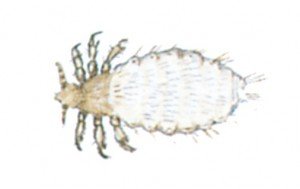
( Latin: Anoplura )
The members of this small insect group show many adaptations for their specialised parasitic life. They are wingless, have much reduced eyes and their mouth parts are made for biting and sucking.
The skin of a louse is leathery and greyish, and the abdomen becomes much distended when full of blood. Each leg ends in a claw which can grip hairs.
Lice feed exclusively on blood and as they have to feed twice a day if they are to remain in good condition they can only survive for a few days in the absence of a host. A louse that is really hungry may be so greedy when it does again find a host that it feeds until it almost bursts.
Lice are completely dependent upon the special microclimate found near the surface of the skin. If the temperature changes as, for example, when the host has a fever, they will move away, and in former times it was regarded as a very bad sign when lice left their host. Lice also move off very quickly from a cold, dead person and this naturally increases the risk of spreading infection during epidemics.
A female louse lays about 10 eggs per day during its month of life. The eggs are quite large and yellowish-white and so firmly attached that it is almost impossible to remove them. After about a week the egg is ready to hatch and the young louse inside inflates itself with air, pushes off the top of the egg and crawls out. The newly hatched louse starts to feed immediately and after about 8 days it is ready to mate and lay eggs. A population of lice can therefore increase at a fast rate.
Lice are by no means a new problem, most mammals harbour their own special species and there is no doubt that our primate ancestors also harboured them. It is, in fact, probable that the louse found on modern man is the same or is closely related to the species that infested early man. In most periods of history lice have been regarded as something that one lived with, and the job of delousing one another was an important part of family life.
Two types of louse are adapted for living on man: the human louse and the crab louse.
The human louse occurs in two forms, the body louse and the head louse, and these are very similar to one another. In fact they can only be distinguished with certainty by their habits.




